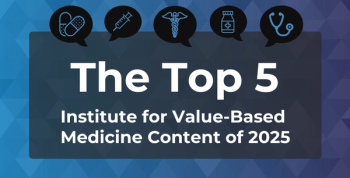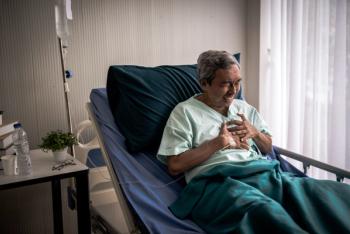
Addressing Whole Health Takes Rethinking Partnerships, Metrics, and Delivery
The opening plenary session addresses a key priority of ISPOR on the first full day of the annual conference.
Denise Webb is a college sophomore who makes a compelling case for bringing more youth to the table to tackle health care disparities. The young Atlanta woman described herself as a volunteer, a worker, an author, “and a few other things.”
“But I’m also a statistic. I am 1 of 500,000 people in Georgia who have lived in low-income spaces," she said. "I am 1 of 700,000 people in Georgia who has severe asthma. I am also 1 of the 36,000 youth who went through homelessness during their K-12 career, and I’m also 1 of the millions in Georgia who are part of health and nutrition deserts.”
Webb was part of the plenary session that opened the 2024 meeting of ISPOR—The Professional Society for Health Economics and Outcomes Research meeting in Atlanta, Georgia. Moderated by Charlene Wong, MD, MSHP, a pediatrician and senior advisor to the director for Health Strategy at CDC, the panel, “Advancing Whole Health, How do We Know We’re Succeeding?” featured 2 more primary care physicians with policy roles:
- Seth Berkowitz, MD, MPH, associate professor of general medicine and clinical epidemiology at University of North Carolina Chapel Hill, and
- Eric Schneider, MD, MSc, FACP, executive vice president, National Committee for Quality Assurance (NCQA.
Use of health economics and outcomes research to advance wholistic health—referring to the physical, behavioral, social, and spiritual factors that affect outcomes—is the 2024 meeting theme and among the policy priorities for ISPOR outlined by the group’s president, Brian O’Rourke, PharmD. This is consistent with current policy priorities of CMS as well as several leading clinical organizations, which seek to reduce health care disparities in multiple ways—from increasing diversity in trials to connecting patients with social services.
Webb offered a vivid account of how the struggle to get through the day made the idea of seeing a doctor or a dentist “a luxury.” Many providers where she lived would not accept Medicaid. At times, she had to choose between groceries and visiting an emergency clinic.
There were times when Webb and her sister did not want to go to school. “We often had to sleep on the floor, or sleep on couches, sleep on air mattresses. We also had to go to school kind of smelling like moth balls or smelling like bug spray, smelling like mildew,” she said. “All of those factors contributed detrimental effects to our health; not just our physical health, but our mental health as well.”
“Worrying about your health is also a luxury,” she told the health policy experts. “You cannot worry about your health, if you cannot afford to fix it.
“So, I ask all of you, those who are in this room, who have the resources, who have the education, who can help people in my community—what can you do stop this. There are people in the community who don't have PhDs, who don't have master's degrees who don't have a high school diploma or bachelor's, and they're out living the exact same issues we're talking about today.”
Both Berkowitz and Schneider said that the need for health systems to address social needs is real. In North Carolina, Berkowitz is leading a
“Now, as you might expect in our Medicaid insurance program, which is for people who are poor and don't have insurance from commercial sector, about three quarters of those folks have unmet social need,” Schneider said. “But actually, the more impressive figure here is that even among people with group health insurance, whether it's commercial Medicare or other programs, almost half of those folks (48%) have health-related social needs.
“The connection between health and unmet health related social needs is actually very clear from the evidence,” he said. “So, it really is incumbent on us not to ignore these results.”
Wong then led the panel through a discussion to identify personal, team-based, and system level approaches that would help promote the advancement of wholistic health.
From “Patient-Centered” to “Person-Centered”
“It’s so important to understand the stories of what happens when people leave the clinic,” Webb said. There were many times she went long stretches between doctors’ visits, and often she was made to feel embarrassed when she finally made an appointment.
Schneider concurred. Early in his career, he said he was very focused on patients’ disease. “Things weren’t working until I started asking about the home situation,” and learning who had no jobs or no food. Berkowitz said to be person-centered, primary care must focus not just on metrics as the outcome, but what people what to do with their lives if they stay healthy.
“It’s hard to know about unmet social needs if you don’t ask,” said Wong. And then, practices need to be ready with solutions, whether it’s emergency food or the ability to enroll patients in nutrition assistance. Berkowitz and Schneider discussed the emergence of newer team members such as the community health worker, and the concept of primary care as a “team sport” that meets the person where they are.
Webb said the use of community ambassadors who can help health care leaders bridge gaps is essential to gain trust and access to information that members might not easily surrender.
Moving From Health Care to Health
Berkowitz said planning system-level changes requires looking at structure—from health care costs to utilization, to patient experience. He encouraged a broad perspective. He and Schneider talked a length about the need for the United States to gain a better understanding of the connections between early investment in what children need and outcomes on the other end; Schneider said 3 social needs matter most: housing, transportation, and food security.
“I want to make that connection here between these social mediums and the cost of care,” Schneider said. Governments and employers end up spending more on health care on the back end because not enough is spent on the front end on social needs, relative to European countries. “So, I think that's another important aspect of this—to think about what are the incentives?”
Wong said as a pediatrician, she agreed. The data show that children are not “little adults” and their social needs are much greater.
Berkowitz pointed to the “wrong pocket” problem, where when social expenditures are made, the savings are realized in another part of the budget and thus the benefits of the investment are not recognized.
From Invisible to Visible
Wong named this last part of the discussion because she wanted to turn the discussion back to Webb and ask how health systems can see the people that are not being seen. Children, in particular, need more support in the system.
New models are needed, such as building evidence on what happens when you rewarding pediatricians who get children into prekindergarten programs. “Part of the reason we do this is to generate the data,” Wong said.
Schneider and Wong both called for more collaboration with health economists to generate that data, as well as collaborations with non-traditional partners outside health care.
Webb said repeatedly: get young people to the table.
“Young people don’t wake up at 18 [years old] and realize the disparities they have been facing,” she said. “It’s so important to make sure everyone’s voices are being heard.”
Newsletter
Stay ahead of policy, cost, and value—subscribe to AJMC for expert insights at the intersection of clinical care and health economics.







































